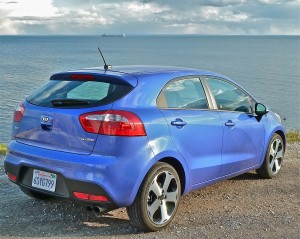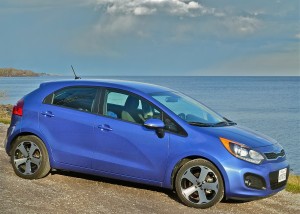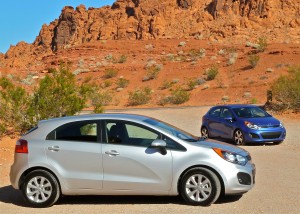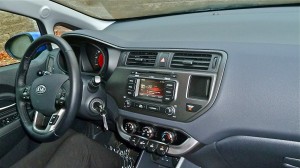Kia Rio scrambles 2012 subcompact list
By John Gilbert
The Kia Rio evolved up through the 2011 model year into a pretty decent subcompact car, with its low initial price, 10-year, 100,000-mile warranty, and rank of “not bad†for styling, roominess, economy, and performance.
That was “then,†as of 2011’s rapidly ending model year, and this is “now,†the future, as of the introduction of the 2012 Rio, which reinforces the low-price/long-warranty tradition but vaults beyond that to the upper echelon of subcompacts. It raises the rank from “not bad†to “outstanding†for performance and economy, roominess, solid safety construction, advanced technology, and dramatic looks. Styling, admittedly, is in the eye of the beholder, but you soon notice that virtually all of the beholders have their eyes on the Rio.
“Consumers initially buy with their eyes,†said Ralph Tjoa, national manager of Kia’s product planning. “We’ve changed just about everything — the engine, transmission and platform — and improved its fuel economy, value and safety. It’s no longer a penalty box; now it’s a box suite.â€
Kia’s rise from back lot to suite-level has escalated dramatically in the last two years, as it finds ways to slip out of the shadow of Hyundai, its corporate parent and partner, and by far the leading auto manufacturer in Korea. Kia might have became the latest “former†Korean automaker, had Hyundai not taken over to streamline it manufacturing, drivetrains, platforms and technical advances. As Hyundai shot up to prominence, particularly with the introduction of the 2011 Sonata, Kia followed along dutifully, with quite similar vehicles in every category. Kia made a bold departure when it hired Peter Schreyer, a designer from Audi. His top achievement so far is the 2011 Kia Optima, which followed Hyundai’s sizzling and high-tech midsize Sonata and set its own styling standard.
Schreyer had nothing to do with the Soul, a boxy but popular subcompact with hamster-induced advertising success, but he did have a hand in the Sportage, a stylish crossover SUV based on the Hyundai Tucson. Hyundai struck marketplace gold with its new Elantra compact this year, while Kia already has its Forte. The subcompact segment was next, and Hyundai’s exceptional remake of the Accent is loaded with technical and performance advances, full of features and capable of 40-miles-per-gallon for $14,000.
Hyundai continues to stress technology aimed at economy, and Kia seeks to be sportier and more style oriented. Hyundai’s Elantra, Accent, and sporty coupe Veloster — based on the Elantra platform, with the slick new 1.6 Accent engine — are all candidates with considerable merit for the 2012 North American Car of the Year.

Out first as a sporty hatchback, a sleek Rio sedan will follow offering 40 mpg at prices from $13,000 and up.
Against that Hyundai hat trick from its partner/parent, Kia unveils the Rio — its uniquely styled version of the Accent. Hyundai executives might wonder if one of their trio might win Car of the Year, but the Kia Rio offers stiff competition from yet another Korean candidate.
The subcompact segment is expected to sell 400,000 vehicles for the 2011 model year, and Kia estimates it will double by 2015, because of continued U.S. determination to downsize to inexpensive and economical cars that also can have some flair. The segment has expanded with all new cars such as the Ford Fiesta, Chevrolet Sonic, Fiat 500, Mini Cooper, Honda Fit, Mazda2, Toyota Yaris and several Scion models, and Nissan Versa. Kia officials are determined to prove the Rio is prominent against such cars.
First, buyers starting with their eyes will like the styling, with the blunt front end featuring Kia’s signature grille, and the shape of the 5-door hatchback is smooth as a teardrop, with a sleeker 4-door sedan following by the first of the year. Inside, the instrument panel, dashboard and interior trim are of the highest quality, as Kia sought to surprise occupants with amenities they might not expect in an inexpensive subcompact.
The engine is a prize, the third generation of the corporation’s Gamma 4-cylinder, reconstructed entirely out of aluminum for a 28-pound reduction from its iron predecessor. It measures 1600 cc. in displacement, with high-pressure direct injection and dual variable valve-timing, delivering 138 horsepower at 6,300 RPMs and 123 foot-pounds of torque at 4,850 RPMs.
Unlike the segment standard Honda Fit, which is available with only 5-speed stick or automatic, the Rio transmissions are both 6-speeds, and both are spaced to wide ratios. That is a welcome relief to small-car owners who have had to live with close-ratio gearing that requires shifting much more frequently. The engine has plenty of torque to pull itself through most situations without downshifting, and it also is greatly responsible for hitting its 40-mpg target.
My wife, Joan, drove a test-fleet Rio with a 6-speed stick on a freeway trip and reported that she attained 38 miles per gallon but sheepishly admitted the car ran so smooth and so free of engine noise that she didn’t realize she had drive more than 50 miles in fifth gear. I laughed at that, but later I drove it on a 165-mile freeway run and as I glanced around at the interior appointments and the neat little row of toggle-switch controls, I spotted the shift lever — in fifth.
Designed for durability, power and fuel-efficiency, the new 1.6 was tested by being run at wide-open throttle for 300 hours, with nary a failure. The Rio, which is introduced first in 5-door form, with the 4-door to follow, will also add a switchable Eco-mode, which upshifts sooner to get to a more economical gear, and downshifts later, to keep you in the more-economical range by preventing higher-rev deceleration. By switching it off, Rio drivers in a hurry can get quicker shifts.
Kia’s new trick is ISG — for Idle Stop and Go. Just like the best hybrids, the Rio engine shuts off when you come to a full stop, such as at a red light. When your foot comes off the brake, it seamlessly restarts. Some top Mercedes will do that too, and it seems very likely that the trend will spread through the industry as a fuel-saving and emission-reducing tactic. But the trick is unique to Rio among subcopacts. Hybrids, of course, have a lot of electrical power on hand, while the Rio with ISG has a more potent battery, a stronger starter geared to 350,000 starts, and a huskier, 130-amp alternator, to maintain accessory use. The air-conditioning compressor, for example, shuts down, too, but a thermal override can restart the car if the battery power starts to dwindle.
I’ve driven Rios in the Texas Hill Country west of Austin, during a week all around Minnesota, and outside Las Vegas during a second intro timed with the annual SEMA electronics show on Halloween week. The trouble with Halloween in Vegas is that you see enough bizarre outfits hitting the casinos the
next day to wonder if there is a discernible difference from the Halloween costumes. The car in Las Vegas had ISG, and when I drove through the spectacular rock formations and stopped at a Ranger station entering Valley of Fire State Park, sure enough, the engine shut down.
The engine and transmission are a significant part of the Rio story, as is the styling, but another is the solid feel and stability of the Rio, which relates to its structural safety. Kia designed the 5-door to be a bit sportier, finding that men preferred it in market research, while the 4-door sedan with its flowing lines was preferred by women. In either case, the Rio body is made of 63 percent high-tensile steel, including a halo safety structure that runs from the platform, up the center B-pillars, and across a two-part roof-rail to form a full hoop of structural security. Another hoop encircles the tailgate on the 5-door.
Using high-tensile steel is expensive, but Hyundai owns its own steel plant. A contemporary benefit of using high-grade steel is it can remain stronger than normal steel, even if it is made thinner for lighter weight, but Kia went the other way — the Rio body panels are 1.6 mm., thicker than the 1.3 mm. in previous years. The design and increased body thickness gives the Rio a 31 percent improvement in torsional rigidity.
The new Rio is less than an inch longer, to 159.3 inches, with a 2.8-inch longer wheelbase, to 101.2, meaning the wheels are closer to the extremities. It is an inch wider, at 67.7 inches, and just over a half-inch lower. That translates into a more stable stance while driving, and more interior room, particularly front head and leg room, where a longer seat-sliding range also adds to what Kia calls the premium experience inside the Rio.
Excluding destination fees, Rio’s prices range start with the LX at $13,600 for the 4-door stick, and $14,700 for the 5-door automatic; the EX at $16,500 for the sedan and $17,500 for the 5-door; and the SX at $17,700 for the sedan and $19,900 for the 5-door. In all cases, air-conditioning, power steering, stability control, an impressive audio system, connectivity of USB jacks are standard. Options include power locks and keyless entry and ignition with the power package, and a premium package adds 17-inch wheels, larger 11-inch front disc brakes, leather seating, a recalibrated steering.
Comparing to the competition, Kia officials said the Rio LX 5-door at $14,700 adds up well against the similarly equipped Versa ($15,380), Sonic ($15,705), Fit ($15,975), and Fiesta ($16,545). Kia figures that none of its competitors can match the Rio’s uncompromising high-tech powertrain and versatility, real-world 40-mpg performance, and the premium feel and amenities inside. Whether consumers buy with their eyes, with their heads, or with their well-cushioned rear ends, the Rio demands to be considered with the best in the segment.
Comments
Tell me what you're thinking...
and oh, if you want a pic to show with your comment, go get a gravatar!






 John Gilbert is a lifetime Minnesotan and career journalist, specializing in cars and sports during and since spending 30 years at the Minneapolis Tribune, now the Star Tribune. More recently, he has continued translating the high-tech world of autos and sharing his passionate insights as a freelance writer/photographer/broadcaster. A member of the prestigious North American Car and Truck of the Year jury since 1993. John can be heard Monday-Friday from 9-11am on 610 KDAL(www.kdal610.com) on the "John Gilbert Show," and writes a column in the Duluth Reader.
John Gilbert is a lifetime Minnesotan and career journalist, specializing in cars and sports during and since spending 30 years at the Minneapolis Tribune, now the Star Tribune. More recently, he has continued translating the high-tech world of autos and sharing his passionate insights as a freelance writer/photographer/broadcaster. A member of the prestigious North American Car and Truck of the Year jury since 1993. John can be heard Monday-Friday from 9-11am on 610 KDAL(www.kdal610.com) on the "John Gilbert Show," and writes a column in the Duluth Reader.